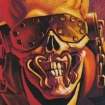Dave Mustaine's acrimonious split with Metallica on April 11th, 1983, has become a piece of metal lore. Before they recorded their groundbreaking debut, Kill 'Em All, in New York – one that Mustaine played a major role in composing – Metallica fired their lead guitarist for being a "violent drunk." As the story goes, the band woke him up after a night of drinking, handed him a bus ticket back to Los Angeles, drove him to Port Authority bus terminal in Manhattan and unceremoniously sent him on his way — then immediately brought in Exodus guitarist Kirk Hammett to replace him.
The firing sowed the seeds for Mustaine's new band, Megadeth, and set the wheels in motion for the group's first album, Killing Is My Business… And Business Is Good, which upped the ante on the technical thrash he started exploring with Metallica. Everything about Megadeth was originally an effort to one-up his former band, which hadn't yet been signed to Elektra, but was causing jaws to drop everywhere it went. "I was out for blood," the Megadeth main man wrote in his 2011 book Mustaine: A Heavy Metal Memoir. "I wanted to kick Metallica's ass."
Mustaine started Megadeth with his downstairs neighbor, bassist David Ellefson, and the band went through various players (including, briefly, Kerry King) before enlisting guitarist Chris Poland and drummer Gar Samuelson. The two had played together in an L.A. jazz fusion band and could lock into a groove with preternatural instinct. While both battled heroin addiction, and Samuelson more than occasionally pawned his gear so he could score, when they were tuned in, their swinging groove perfectly complimented Mustaine's aggressive swagger.
Megadeth's Killing Is My Business… And Business Is Good didn't sound as heavy as most thrash records – the production was weak, with tinny guitars and thin drums – but the band more than made up for any sonic deficiencies with bristling, technically challenging songs that introduced one of metal's greatest bands onto the scene. Here — with a deluxe remixed and remastered reissue of the album, dubbed Killing Is My Business... And Business Is Good - The Final Kill, newly in stores — we look back at some little-known facts about Megadeth's momentous debut.
1. The first Megadeth album was originally intended to include lots of parts Dave Mustaine wrote for Metallica
Before he was booted from Metallica, Mustaine wrote plenty of strong material for the group. He planned to rejigger his parts for Megadeth's debut. "I set out to make my new band faster and heavier than theirs and had most of my music that oddly ended up on Kill 'Em All set to be recorded for our first musical offering," Mustaine wrote in the liner notes of the 2002 reissue of Killing Is My Business… And Business Is Good! "That was snuffed out when I listened to their first record and realized they went through with recording my stuff after I asked them not to." In the end, only "The Mechanix," which appeared on the now-famous No Life Til Leather demo, and which Metallica later slowed down and revamped into "The Four Horsemen," appeared on Killing Is My Business…
2. Mustaine nearly brought in another vocalist to sing on the record
Before Megadeth entered the studio to start recording Killing Is My Business… , they were working with a singer named Billy Bonds, and everyone in the band liked his voice. But Bonds made the ill-advised decision to arrive at rehearsal one night wearing makeup and eyeliner and was immediately booted from the group. "I didn't care if the guy could sing like Robert Plant," Mustaine said in his memoir. "There was no way some glam-band wannabe would be the face of Megadeth." With little time to audition new singers, bassist Dave Ellefson suggested Mustaine try singing. "It took time to learn the proper technique," Mustaine wrote. "I didn't know how to breathe efficiently or how to pace myself so I wouldn't wreck my vocal cords. Consequently, I developed a unique singing voice."
3. While working on the album, Gar Samuelson introduced Mustaine to heroin and crack
Mustaine was hanging out at Samuelson's house one day while the drummer was waxing rhapsodic about the creative benefits of narcotics. When Mustaine asked him why he did heroin, Samuelson suggested he try it out for himself. Curious, Megadeth's frontman snorted a line of heroin. "It was just a small amount, so there was no great rush," he wrote in Mustaine. "Just a warm sensation followed by a short nap." When he woke up, Samuelson and his brother were hitting a crack pipe and giggling away. Mustaine gave that a shot, as well, and immediately became dizzy and nauseous. He ran to the bathroom and puked his guts out, then lay gasping on the floor. That's when drug hit him. "The nausea and dizziness were gone, replaced by the most amazing euphoria I'd ever experienced," he wrote. "… The thing about drug addiction is that it is not all piss and puke. Sometimes it's actually a lot of fun … until it gets out of hand, which it invariably does, and then it takes your fucking heart and soul, and everything else you have to give."
4. The band had a budget of $8,000 to record the album and blew half of it right away on drugs and ... meat
Megadeth's first manager, cocaine dealer Jay Jones (who had worked with Circle Jerks and some rap artists), arrived at Indigo Ranch studio in Malibu, California, with Poland and Samuelson, carrying $4,000 of coke, heroin and about 100 pounds of frozen hamburger meat, wrote Mustaine. Within a week, Megadeth were out of drugs and unable to create. They fired Jones and received an extra $4,000 from their label. Without the cash to hire a well-known producer, Mustaine brought in his roommate and engineer Karat Fay, who had once worked with Kiss, and the two co-produced the album. Mustaine later admitted that the mishandling of funds resulted in the under-produced sound of the original recording.
5. The band came up with the album title during a visit to an Army surplus store
Perusing the items at the store, Megadeth saw one that bore the slogan, "Killing is my business… And business is good!" They were immediately struck by the phrase. "We knew immediately it would become a song or lyric," Ellefson wrote in the liner notes for the 2002 edition of Killing Is My Business... In addition to digging the aggressiveness of the slogan, Mustaine liked the idea of ellipses separating the phrases and he used the technique in the titles of the band's next two albums, Peace Sells… But Who's Buying?, So Far, So Good… So What! and in the song titles on Rust in Peace ("Holy Wars… The Punishment Due" and "Rust In Peace… Polaris").
6. The song "Killing Is My Business… And Business Is Good!" was inspired by Mustaine's childhood fascination with comic books
From an early age, after discovering Iron Man and Captain America, Mustaine was a big fan of comic books; Megadeth mascot Vic Rattlehead was intended as an homage to this childhood love, and the title track of Killing Is My Business… is about The Punisher. "The ironic twist is that the hit man has been paid to kill someone and once he is done he actually kills his employer who has been marked for assassination, also," Mustaine wrote in the album liner notes.
7. Lee Hazlewood hated Megadeth's cover of his song "These Boots Are Made for Walkin'"
In addition to the seven originals on Killing Is My Business… , Mustaine decided to include a cover of the 1966 Lee Hazlewood song "These Boots Are Made For Walkin'," which was made famous by Nancy Sinatra. Megadeth changed the name to "These Boots" and sped up and metal-ized the tune. Mustaine also altered the lyrics: "Something you call love, but confess" became "Something you call love, but I call sex," and "You've been a'messin' where you shouldn't 've been a'messin'/Now someone else is getting all your best" was changed to "You've been kissing when you oughta be screwing/And now someone else can kiss your ass." Years after the album's release, Hazlewood demanded that the band remove the altered lyrics from subsequent pressings. When Megadeth issued 2002's remastered version of Killing Is My Business…, they included "These Boots," but bleeped out all of Mustaine's changes. A brand new remastered reissue features the song with re-recorded vocals of Hazlewood's original lyrics. "I honestly thought the changes were so small as to be insignificant," wrote Mustaine. "But Lee felt [they were] 'vile and offensive.'" In the 2002 liner notes, Mustaine added, "I thought it was alright to have some fun with it because the original version sucked. Hazlewood didn't quite see the humor in this."

8. The original cover art for Killing Is My Business… did not turn out at all like what Mustaine had in mind
When Combat Records was getting ready to prepare the album art, Mustaine handed in a rough sketch of the cover as he envisioned it — an image that was meant to express how he felt about religion, censorship and freedom of expression. The design featured a skull and crossbones with extra pairs of bones meant to resemble crucifixes. The skull was supposed to be the first rendering of the band's mascot Vic Rattlehead, a living skeleton whose eyes, ears and mouth were sealed shut as a metaphor for the saying, "See no evil, hear no evil, speak no evil." Combat assured Mustaine they'd roll with his idea. Then they dropped the ball. "I don't really know what happened to the cover art I suggested," wrote Mustaine in his book. "The formidable Vic had been reduced to a caricature. Rather than a brilliant and disturbing image, the cover of Killing Is My Business… featured what appeared to be a plastic Halloween skull and a variety of dime-store accouterments. It looked as though someone had turned a beer can inside out and used it as a visor to cover the eyes. The blood looked like ketchup. Everything about the design smacked of amateurism." Mustaine's original art concept was resurrected for the album's reissues.












